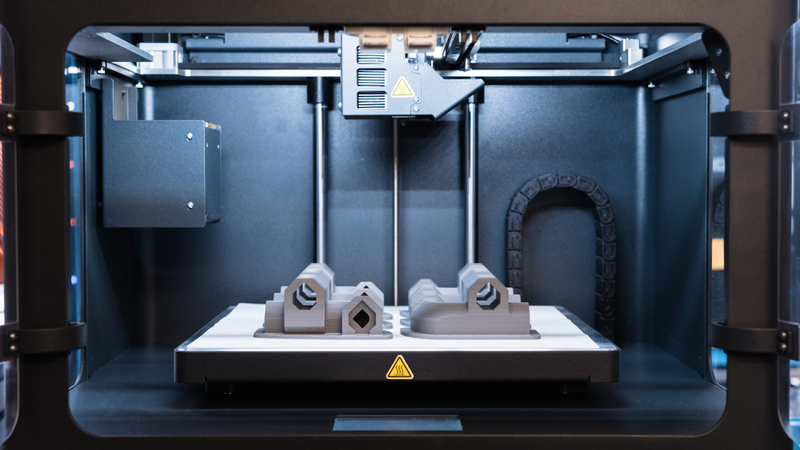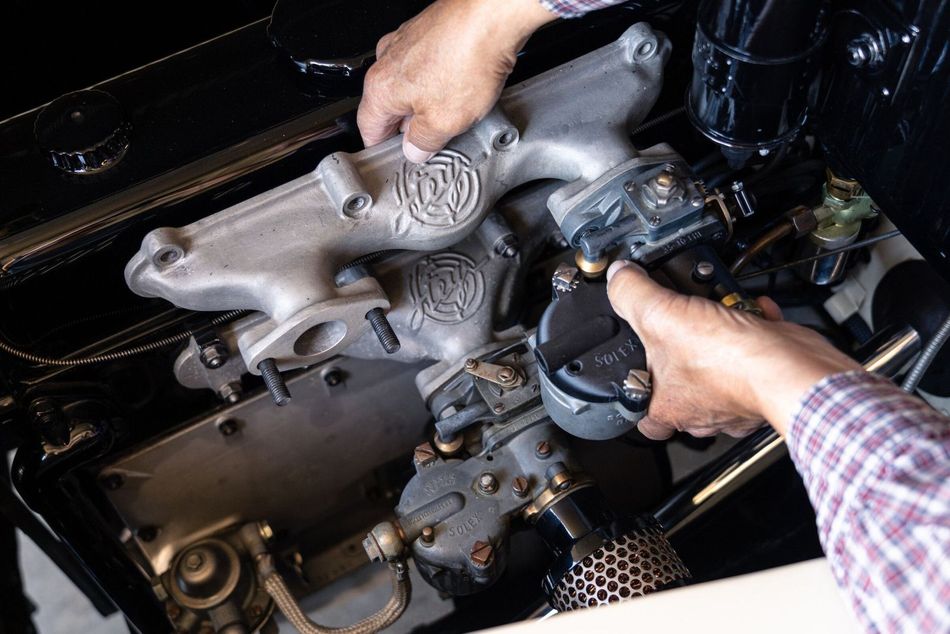Breaking down production barriers with scalable & affordable metal 3D printing
Markforged’s cost-effective Metal X solution brings the benefits of metal additive manufacturing to a wider adoption base.
Metal additive manufacturing (AM) has been around for nearly three decades and has had a massive impact on how metal parts are made, especially in industries where complex designs and low-volume production runs are required. Today, the most common form of metal 3D printing is powder-based sintering technology—variously known as selective laser melting (SLM), laser powder bed fusion (LPBF), and direct metal laser sintering (DMLS). While this approach to metal AM has been around the longest and offers many advantages—including the ability to produce highly complex, precise parts—it also has its fair share of limitations.
For instance, cost is a major limiting factor associated with SLM machines. Not only is the hardware prohibitively expensive (with some systems costing in the range of $1 million), the metal powder used as raw material is also pricey, due to the fact that it has to be pure and uniform. On top of that, whenever loose metal powder is involved, safety becomes a risk. Powder-based metal 3D printing systems therefore require proper material handling protocols and expert operators, which also comes at a cost. All in all, this has resulted in these technologies being mostly limited to industrial users with substantial resources at their disposal.
Fortunately, there are more accessible metal 3D printing technologies available, including Bound Powder Extrusion (BPE). This technology, commercialized by Markforged via the Metal X 3D printer, is breaking down barriers to the adoption of metal 3D printing, providing an affordable, user-friendly, and scalable process for creating functional metal components.
Metal X Benefits
In a segment dominated by complex, costly technologies, Markforged’s Metal X solution offers a welcome alternative. Let’s take a closer look at the technology’s main benefits:
Cost
One of the primary benefits is the technology’s lower price point. Metal X hardware and materials are substantially cheaper (as much as 10x) than other metal additive processes and consumables, as well as more cost effective than traditional metal manufacturing processes, such as machining or casting.
High quality
On top of affordability, the Metal X system produces high quality metal components. With very few design constraints and the ability to print open cell infill, the machine can print functional end-use components with highly complex geometries, like organic structures and internal channels. On top of that, the machine can print at layer heights down to 50 microns and can achieve up to 99.7% density post sintering. Production Speed
The entire Metal X workflow—from print preparation, to sintering—is designed to accelerate production times for metal components. The purpose-built solution can deliver high-quality end-use parts in as little as 28 hours, enabling manufacturers to dramatically cut their lead times as well as improve their production agility. If a part needs a quick redesign or if a replacement component is needed on the fly, it takes days rather than months to bring it to life.
User-friendly
The Metal X process is safe and simple to use. The process relies on bound metal filaments, which can be safely handled without the need for a dedicated powder management system. The three-step production chain is also intuitive, not requiring an expert technician to operate or supervise it. This means that Metal X can be installed on a factory floor or in an office.
Scalable
Users can easily scale their production capacity using the Metal X system by adding more printer units. On top of that, a single machine can turn out functional components in as little as 28 hours, enabling manufacturers to accelerate lead times and boost throughput. At the same time, the system gives manufacturers a cost-effective way to produce one-off or small batch components—ideal for prototyping, tooling, or custom parts.
From Rapid Prototypes to End-Use Parts
Since Markforged launched the Metal X solution, the technology has been successfully adopted by users across various industries to fulfill a range of industrial production applications, from tooling, to end-use components.
Among these users is RPG Industries, an Ohio-based manufacturer serving clients in the automotive, aerospace, construction, and oil industries. The company, which is continuously looking to optimize its manufacturing capabilities to meet customer requirements, found that Metal X would be a perfect fit for its workfloor, providing the benefits of metal 3D printing (namely production agility and design freedom) while also being safer and cheaper than powder-based technologies.
RPG Industries successfully used Metal X to print a replacement carburetor cap for its client D&D Classic Automotive Restoration. When the original component—part of a classic car from the 1930s—was found to be defective and a replacement could not be found, the only viable option was to print it. RPG Industries was enlisted to 3D scan the broken carburetor cap, reverse engineer it, and 3D print it using Metal X. The part was ultimately printed using 17.4 PH Stainless Steel and was installed under the hood to bring the vintage car back to a working state.
SQP Engineering, a family-owned industrial manufacturing provider based out of Perth, Australia, has also upgraded its capabilities with Metal X. There, the technology is being used to fulfill requests for specialized parts that are impossible or too expensive to machine. With Metal X (as well as Markforged’s FX20) in its arsenal, SQP can produce a wider variety of production parts, all while offering clients faster turnaround times and competitive costs.
Of course, that’s just the tip of the iceberg, many other manufacturers have adopted or are utilizing the Metal X Solution, including Fortune 500 company Dana Incorporated, which has dramatically accelerated its rapid prototyping with Markforged solutions, as well as Caldwell Manufacturing, Guhring UK, BMF GmbH, Sandia National Labs, and many more.
How the Metal X Process Works
The Metal X system is a cost-effective solution for producing functional metal components for a range of industries and applications, such as tooling and production parts. The solution itself comprises a few steps, starting with Markforged’s end-to-end Eiger cloud software and finishing with an intuitive two-step post-process. Let’s take a look at each step in the Metal X production flow:
Eiger Slicing
When usingMetal X, users begin by uploading their 3D model to Eiger. The software program preps the model for printing, allowing users to choose a print orientation, as well as automatically scaling the part to account for shrinkage that occurs in the sintering stage, and generating supports and rafts. The 3D model is then sliced and sent to the printer. (Eiger software also functions as an end-to-end print management solution, allowing users to track the progress of the workflow.)
Metal X Printing
Markforged’s Metal X technology is similar to polymer-based Fused Filament Fabrication (FFF) in that it uses filament as raw material and a heated nozzle to extrude the melted material onto a build platform, building components up layer by layer. Unlike polymer FFF, however, the BPE process uses bound metal filament, consisting of metal powder contained in a plastic matrix.
The 3D printer is equipped with a heated chamber and bed, which ensures that the bound metal filament prints at an optimal temperature, and features automated bed leveling for ease of use. The system is also fitted with a second extruder, which deposits a ceramic release material between the metal component and rafts/supports, in order to facilitate their removal.
In terms of materials, Metal X can process a variety of bound metal filaments, including 17-4PH Stainless Steel, Copper, H13 Tool Steel, Inconel 625, and A2 and D2 Tool Steels.
Post-processing
When the print is finished, the green part is removed from the print bed and placed in the Wash-1, a heated debinding machine that uses a cleaning fluid to dissolve much of the polymer binder in the component. From there, the parts are air dried and ready for sintering.
Markforged’s sintering solution, the Sinter-2, transforms brown parts into dense metal components. This is achieved by heating the part inside an enclosed chamber filled with inert and mixed gas. This process removes any remaining binder in the part and fuses the metal particles together to create a strong, functional metal structure. Like the Metal X 3D printer, the Wash-1 and Sinter-2 are both safe and intuitive to use.
Additional post-processing steps, like heat treatment, machining, and polishing can also be employed if needed to further refine dimensional accuracy or improve material properties.
Breaking barriers in metal AM
Overall, Metal X enables a broader base of users to reap the benefits of metal 3D printing, giving them the ability to create complex parts in a safe, cost-effective, and scalable way. You can learn more about Metal X and its specifications here or get in touch with the Markforged team to request a demo and see the machine’s capabilities first hand.
References
[1] Metal X System [Internet]. Markforged, 2023. Available from: https://markforged.com/3d-printers/metal-x
[2] The Markforged Metal Additive Manufacturing Process [internet]. Markforged, 2023. Available from: https://markforged.com/resources/learn/design-for-additive-manufacturing-metals/metal-additive-manufacturing-introduction/metal-additive-manufacturing-process
[3] RPG Industries, Inc. Customer Success Story [Internet]. Markforged, 2023. Available from: https://markforged.com/resources/case-studies/rpg-industries
[4] SQP Engineering Customer Success Story [Internet]. Markforged, 2023. Available from: https://markforged.com/resources/case-studies/sqp-engineering
[5] Dana Incorporated Customer Success Story [Internet]. Markforged, 2023. Available from: https://markforged.com/resources/case-studies/dana-incorporated


